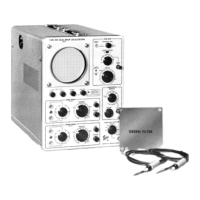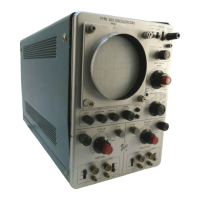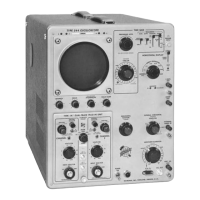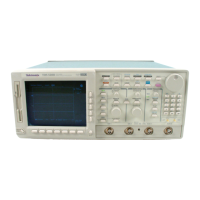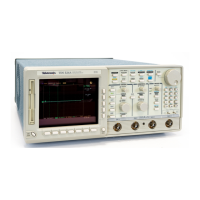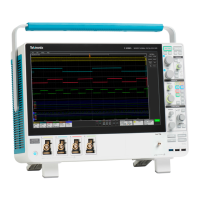Operating
Instructions—
5103N
6.
Measure the vertical deflection in divisions
and deter-
mine the amplitude by the
following
formula:
Div switch
setting by the
Deflection
Conversion Factor
established in step 2.
Signal
Amplitude
Modified
Deflection X
Factor
deflection
(divisions)
Modified
Deflection
Factor
Second
s/Div
switch setting
Deflection
X Conversion
Factor
EXAMPLE:
Assume a
reference
signal
amplitude
of
30
volts,
a Volts/Div switch setting of
5 V
and
a
deflection
of
four
divisions. Substituting
these values
in the
Deflection
Conversion
Factor formula
(step
2):
30
V
(4)
(5
V)
1.5
6.
Measure the
horizontal
deflection in divisions
and
determine the
period by the
following formula:
Modified
horizontal
Period
=
Deflection
X deflection
Factor
(divisions)
Then, with
a Volts/Div switch setting of
2 V, the Modified
Deflection Factor
(step
5)
is:
(2
V)
(1.5)
=
3
volts/division
To determine the peak-to-peak
amplitude of an
applied
signal which produces
a
vertical
deflection of five
divisions
with
the above conditions,
use the Signal
Amplitude
formula
(step
6)
:
(3
V)
(5)
-
15 volts
SWEEP
RATE
1.
Apply a
reference
signal
of
known
frequency
to the
vertical
input connector. Using the
Seconds/Div
switch
and
Variable
Seconds/Div control,
adjust the display
so that
one
cycle of
the signal covers an exact number
of
horizontal
divisions.
Do
not change
the
Variable
Seconds/Div
control
after
obtaining
the
desired
deflection.
2. Divide the period
of
the reference
signal
(seconds)
by
the
product of the horizontal
deflection
in divisions
(estab-
lished
in step
1)
and the
setting
of
the
Seconds/Div
switch.
This is the
Deflection
Conversion
Factor.
Deflection reference signal
period (seconds)
Conversion
=
horizontal
Seconds/Div
Factor
deflection X
switch
(divisions)
setting
3. To determine the period of
an unknown
signal,
dis-
connect
the reference and apply the
unknown signal.
4. Set the
Seconds/Div switch to
a setting that
provides
sufficient horizontal deflection
to make
an accurate
meas-
urement.
Do not
readjust
the
Variable
Seconds/Div
control.
EXAMPLE: Assume a
reference signal
frequency of 455
hertz (period 2.2
milliseconds), a
Seconds/Div switch
setting
of
.2 ms,
and a
horizontal deflection of eight divi-
sions.
Substituting these
values in the Deflection
Conver-
sion
Factor
formula (step
2):
(8)
(0.2
ms)
Then,
with
a
Seconds/Div switch
setting of
50
jus, the Modi-
fied
Deflection
Factor (step
5)
is:
(50jus)
(1.375)
=
68.75
microseconds/division
To
determine the time period
of
an
applied signal
which
completes one
cycle in seven horizontal divisions, use
the
Period formula (step
6):
(68.75
jus)
(7)
-
481
microseconds
This product can
be converted to frequency by
taking the
reciprocal
of
the
period (see application on
Determining
Frequency).
Time Period
Measurement
To measure the
time (period) between two points
on
a
waveform, use the
following procedure:
1.
Connect
the signal to the vertical input
connector,
select either
AC
or
DC
input coupling, and set the
Volts/
Div
switch
to
display about four divisions
of
the
waveform.
2.
Set
the time-base triggering controls to
obtain
a
stable
display. Set the Seconds/Div
switch
to
the fastest
sweep
rate that will permit displaying one cycle
of the
waveform in less than eight divisions (some
non-linearity
may occur in the
first and last graticule divisions
of dis-
play).
Refer
to Fig.
2-4.
5.
To establish a
Modified
Deflection
Factor
at any
setting of
the Seconds/Div switch, multiply
the
Seconds/
3.
Adjust the
vertical
Position control
to move the
points between which
the time measurement
is made to the
2-7

